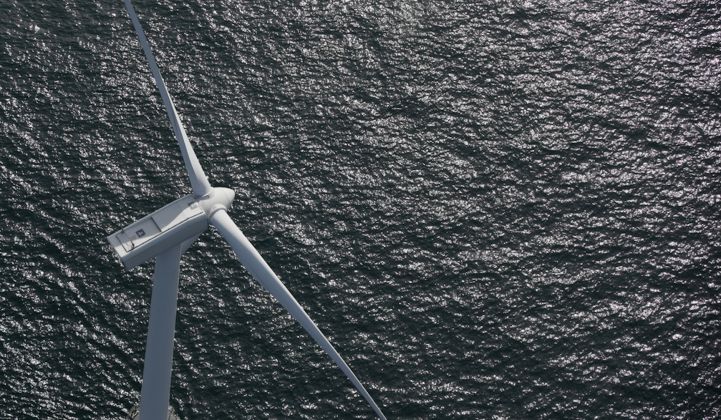A Danish firm recently completed what it says is the world’s first repowering of an offshore wind farm.
While small in scale — the wind farm comprises just five turbines — lessons learned from the project could provide guidance for project owners as Europe’s early utility-scale offshore wind farms age over the next decade.
Last month, Danish wind and solar power project manager Momentum Gruppen A/S (Momentum Group) recommissioned five refurbished turbines at the Bockstigen wind farm located 4 kilometers off the coast of the Swedish island of Gotland.
The project is a partial repowering of a project originally commissioned in March 1998. Momentum Group replaced the nacelles, blades and control systems of five 20-year-old, 550-kilowatt Wind World A/S turbines with replacement components sourced from five refurbished V47-660 kilowatt turbines manufactured by Vestas Wind Systems A/S.
Momentum Group was able to salvage and reuse the original turbine towers, foundations and transmission cables.
According to the company, the repowering will extend the life of the project by at least another 15 years and more than double the expected annual electricity generation from 5,000 megawatt-hours to 11,000 megawatt-hours.
GTM asked Momentum Group CEO Kim Madsen about that expected doubling of power output.
“Apart from a larger generator, and a totally refurbished, younger and more modern turbine, there are several reasons for this increase,” he wrote in an email.
After the repowering, the rotor diameter increased from 38 meters to 47 meters, boosting the energy-harvesting swept area for each turbine. And updated software and a new control system enable better control of the turbines from shore.
Transmission constraints prevented a full-scale repowering
Repowering has been under consideration for the Bockstigen project for some time. As far back as 2012, the previous owner floated a plan to decommission the five existing turbines and replace them with 10 new turbines as large as 5 megawatts apiece.
Momentum Group bought the Bockstigen project in early 2015. According to Madsen, the original plan was to decommission the existing wind farm and install a dozen new 4-megawatt turbines at the site. But that plan was contingent on an upgraded interconnection to mainland Sweden.
“A planned 400-kV cable from Gotland to mainland Sweden, was canceled during 2017,” he said. “This made it impossible to do a full repowering of the project.”
“Our Plan B,” he said, “was to exchange the existing five turbines using as much of the turbines and infrastructure as possible.”
Nevertheless, he said, “it has been a very positive experience to make a repowering with used turbines. It gives a new dimension of recycling, cost-saving, and technical life extension on a site with limitations.”
Madsen told Wind Power Offshore the project was completed less than one year after the repowering was first proposed and for less than 5 million euros ($5.6 million).
Future of offshore repowering
Bockstigen, the world’s third offshore wind farm, was at the tail end of its useful life at the time of repowering. Wind turbines are designed to operate for 20 to 25 years.
Offshore wind farms in Denmark, Germany and the U.K. commissioned in the first half of this decade typically installed turbines with a nameplate generating capacity under 4 megawatts. But as manufacturers deploy ever-larger offshore turbines, project owners have the potential via repowering to dramatically increase power generation within the footprint of the existing project site.
MHI Vestas launched sales of a 10-megawatt offshore turbine in September, and GE plans to deploy a 12-megawatt offshore turbine by 2021. Before long, owners of some of the earliest offshore projects with megawatt-size turbines will be assessing the feasibility of partial or full-scale repowering of their projects.
“It’s probably too soon yet,” Giles Dickson, CEO of the trade group WindEurope, told Power magazine in 2016. “But producers are really starting to consider this. It’s not so much that the first generation turbines are aging, but more the fact that advances in turbine size technology are so significant.”
He went on, “Operators are thinking, ‘Why keep generating with a tiny 500-kW turbine when I can repower with an 8-MW turbine that’s 16 times more powerful — and will generate not only more power, but a tremendous amount more revenue?’”
Andrea Scassola, a senior market analyst for Wood Mackenzie Power & Renewables, agrees that in the near term, owners of smaller projects will more likely resort to partial repowering that extends the life of the project.
“Repowering can be a possibility for further projects with kilowatt-size turbines in Sweden (e.g., Lillgrund Wind Farm) and Denmark,” he wrote in an email.
But, as for large projects with megawatt-size turbines, he added, “It’s still too early for most projects in more developed markets such as the U.K. and Germany.”
With time, however, full-scale repowering will become more prevalent, according to Mattia Cecchinato, an offshore and sustainability analyst with WindEurope.
“I think a full repowering project will probably be preferred in the future, if properly backed by support schemes and when not having permitting issues,” he told GTM in an email. “It requires complete replacement of all sub-structures, but the potential increased capacity for an offshore wind farm is much bigger than for onshore.”




